About The Drawings
The drawings in this exhibition were made with pencil and ink on paper. It appears that at least three different artists produced this work, possibly for a classroom assignment or as objects for sale to a Euro-American. The Lopps and other non-Native visitors to the Wales region, including sailors, miners and representative of the U.S. government, attended ceremonials when they occurred. That drawings might be an appropriate souvenir of such an event is suggested by the fact that representations of the Messenger Feast appear in all of the significant collections of works attributed to the Lopps’ students (Fair 2003). Interestingly, many of the scenes are depicted from the same point of view, suggesting either a consensus among students of the best vantage point or, perhaps, that all were working from an original set of drawings or photographs (see Fair 2003). Despite these similarities, the drawings show different ways of handling line, color, shading and the representation of figures in a crowd.
While many of the drawings made under the Lopp’s tutelage were created in notebooks or on lined paper, these drawings are all on heavy, manila-colored sheets. The paper used was from an illustrated magazine published by the Boston firm of Lee and Shepard. Because of the printing technology of the time, wood engravings were often published on one side of page, with the back left blank, offering a convenient canvas upon which these artists could work. It is possible that this similarity suggests that these drawings were part or all of a set of images made at one time, perhaps for one patron.
Below we reproduce both the front and the back of each of the drawings to offer a sense of the Victorian visual culture which surrounded the artists’ encounter with pencils and paper. Clicking on each image will lead to a page with a larger reproduction. Use the drop-down menu to find a reproduction accompanied by some notes on style and content compiled by students. We encourage viewers with more knowledge of the Kivgiq, especially those from Seward Peninsula Inupiaq communities, to share their thoughts about the images in the comments for each of these pages.
Notes on style and technique (Jaime Luria and Elizabeth Hutchinson)
Dissimilarities in the composition of the figures, as well as in evident dedication to detail, points to the presence of multiple hands in making these works. Some drawings appear to be unfinished, while others offer consistent patterns of color and detail of clothing. In some cases, there is inconsistency within the handling of detail in a single drawing, and this may have been intentional. Figure 10 depicts a procession of men in ceremonial regalia, most of which are fully colored in. The left-most figure, however, is hardly more than an outline in pencil. This may have been intended in order to create an effect of perspective.
Some things are constant throughout all of the works, including a sense of formality and an attention to the details of the figures’ facial features, regalia, and pose. Many of the drawings imply a sense of movement through the positioning of limbs or the arrangement of figures in space. Offering a careful record of events witnessed by the artist, the drawings might be interpreted as snapshots of ceremonial protocol and traditional life and careful records of the diverse participants in the Feast. The drawings thus provide what we see as a native-produced record of the Kivgik that supplements and perhaps corrects the records of the ceremonial made by Euro-American recorders.
At the same time, it is impossible to ignore the incorporation of many Euro-American representational strategies in the works. Most use rulers to mark out perspectival space, adding lines to distinguish the dance floor from the platform and back wall of the Qargi. Presumably, the artists were encouraged to work in this style by the Americans among them, most likely by their teachers, who may also have edited or added details to their students’ works. One interesting indication of the artists’ increasing exposure to American visual culture is the fact that many of the images have been surrounded by straight lines which create a rectangular border around the image, suggesting a frame. The inclusion of rounded forms in the corners of some of the drawings might also reference the corners used to hold photographs in an album, reinforcing the notion of these pictures as documents rather than images that extend ealier Inupiat visual traditions.
Essay on these drawings as part of developing Inupiat graphic style
All drawings are owned by Art Properties, Avery Architectural & Fine Arts Library, Columbia University in the City of New York The Bush Collection of Religion and Culture (call numbers C00.1483.299-.308)
Thumbnails
Click on any image for a description and discussion of the work. To request further information or make an appointment to see the drawings after the close of the exhibition, contact artproperties@library.columbia.edu
Drawing A, inventory of regalia used for the Eagle-Wolf Dance (C00.1483.299)
Drawing B, King Island Eagle-Wolf Dancers (C00.1483.300)
Drawing C, King Island Wolf Dancers with audience and musicians (C00.1483.301)
Drawing D, Wolf Dance: the transformation of the eagles into wolves (C00.1483.302)
Drawing E, Men in different clothing with carved pipes (C00.1483.303)
Drawing F, Two men in similar dress sharing berries (C00.1483.304)
Drawing G, Line of Men in Similar Dress (C00.1483.305)
Drawing H, Line of Men in Different Clothing (C00.1483.306)
Drawing J, Ball Game (C00.1483.307)
Drawing K, Dance with Two Women at Center (C00.1483.308)
Sources for this page,
Susan W. Fair, “Early Western Education, Reindeer Herding, and Indian Drawing in Northwest Alaska: Wales, the Saniq Coast, and Shishnaref to Cape Espenberg,” in Jones, ed. Eskimo Drawing. Anchorage: Anchorage Museum of History and Art, 2003. 35-76.
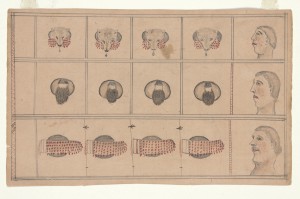

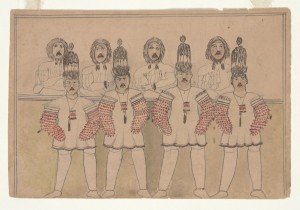
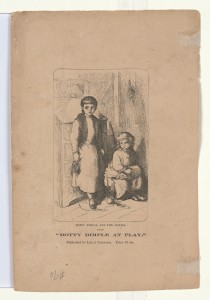
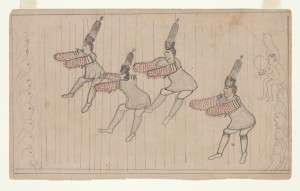
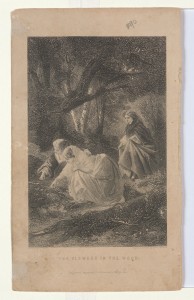

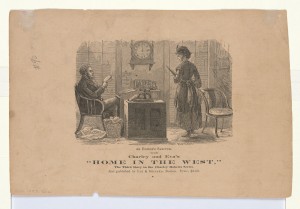
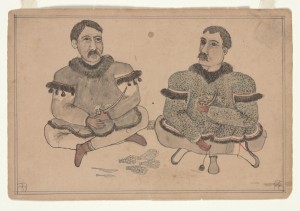
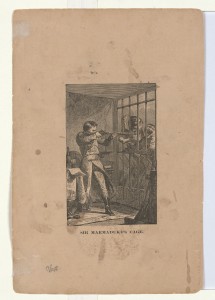
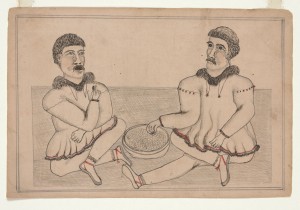
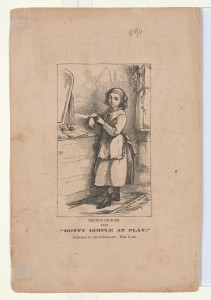
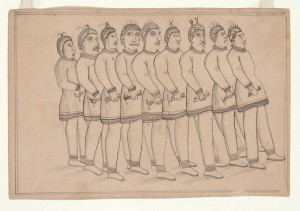
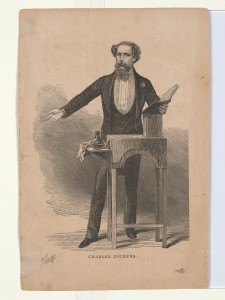
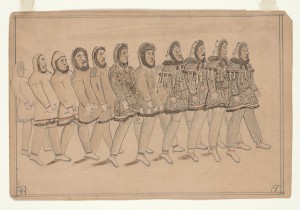
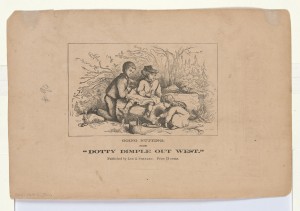

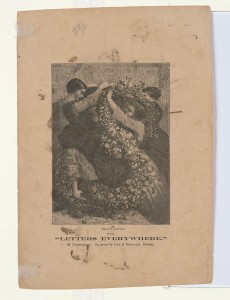
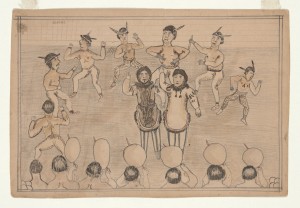
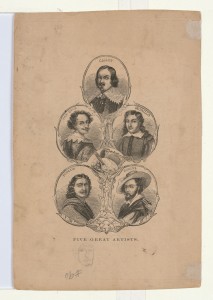
Recent Comments